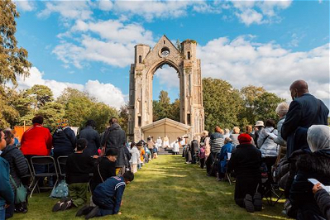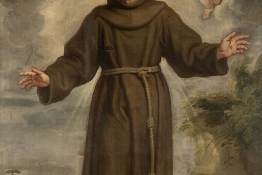Bishop Alan Hopes installed as new Bishop of East Anglia

The Cathedral of St John the Baptist in Norwich resounded with song and applause today (Tuesday 16 July) when Bishop Alan Hopes was installed as the fourth bishop of the Diocese of East Anglia. More than 2000 people from across the Diocese gathered to welcome him, with members of his family and many of his friends from his former Archdiocese of Westminster, where he served for ten years as an auxiliary bishop.
The Apostolic Nuncio, Cardinal Cormac Murphy O’Connor, almost all the Catholic bishops of England and Wales, representatives of the Latin Patriarchate and the Apostolic Prefecture of Battambang were present. Civic guests included the Lord Lieutenant of Norfolk and the Deputy Lord Lieutenant of Suffolk, along with the High Sheriff of Norfolk, the Sheriff of Norwich and mayors from Peterborough and Ipswich, and the Chairmen of Suffolk and Norfolk County Councils. Many ecumenical guests, including Archbishop Gregorios from the Greek Orthodox Church, representatives from the Russian Orthodox and Coptic Orthodox Churches, the Anglican Bishops of Norwich, Ely, St Edmundsbury & Ipswich, and the suffragan bishop of Peterborough, and representatives from the Salvation Army, Eastern Baptists, the United Reformed Church, and the East Anglia Methodists were welcomed to the celebration.
The ceremony of Installation was rich with symbolism. Bishop Alan entered the Great West Doors of the Cathedral and knelt in silent prayer, commending his ministry and all the people of the Diocese to God’s loving care. He was welcomed by Archbishop Vincent Nichols and then by the consultors of the Diocese and Father David Bagstaff, the Diocesan Administrator, who presented him with a crucifix. Fr Peter Brown, the Diocesan Chancellor, read the letter of appointment from Pope Francis and then Bishop Alan was seated in the cathedra, the Bishop’s Chair, the sign of his leadership of the diocese, and presented with the Book of the Gospels and the Crozier. After greeting the civic and ecumenical representatives, Bishop Alan led the congregation in the celebration of the Eucharist.
Bishop Alan said: "Today has been a momentous celebration for the whole of the Catholic Diocese of East Anglia and for me personally, as I come amongst them as their father, their brother and a fellow pilgrim with them.
"I am looking forward to getting to know both the clergy and the people of the Diocese and the richness of a family that covers the three counties of Norfolk, Suffolk and Cambridgeshire and the city of Peterborough. I am also looking forward to getting to know and working with the leaders of the other Christian churches and communities who were present at today’s Installation Mass – it is so important today that Christians work together, in those areas where it is possible to do so, for the benefit of society as a whole.
"I hope that the Catholic Church in East Anglia will continue to be able to engage with the wider community, with those of faith and those of no faith, and I am grateful for the presence of the representatives of both Her Majesty the Queen and civic authorities. I thank them for their welcome and good will.
"I really am so grateful for the genuine warmth and joy of the welcome I have received."
Bishop Alan was born in Oxford in 1944 and moved to London in 1956. He was educated at Oxford High and Enfield Grammar Schools. He read Theology at Kings College, London, and, after completing his degree in 1966, studied at Warminster Theological College and was ordained priest in the Church of England in 1968. He continued in this ministry until 1994, when he was received into the Catholic Church. This followed a long process of prayer and discernment during which he was attracted to the Catholic Church by its clarity of teaching and the nature of its communion under the leadership of the Pope.
He was ordained priest in the Catholic Church in December 1995. After two years as Assistant Priest at Our Lady of Victories in Kensington, London he became parish priest at Holy Redeemer and St Thomas More, Chelsea. In 2001 he was appointed as Vicar General of the Diocese. He was ordained as a bishop, and appointed as an Auxiliary Bishop of the Diocese of Westminster, on 24th January 2003.
Bishop Alan holds several posts of responsibility within the Bishops Conference, including Chairman of the Liturgy Committee, Observer on the International Commission for English in the Liturgy and Co-Ordinator for national ethnic chaplaincies.
The Catholic Diocese of East Anglia was created by Pope Paul VI in the decree Quod Ecumenicum on 13th March 1976. It comprises the counties of Norfolk, Suffolk, Cambridgeshire and the Unitary Authority of Peterborough.
The Diocese has 50 parishes, with additional Mass centres and 31 Catholic schools that serve almost 100,000 Catholics. Over recent years, despite a decline in the number of priests in active ministry, Mass attendance in the Diocese has slowly but surely grown, enriched by new members both from within the United Kingdom and outside. This growing diocese with an abundance of young families, and increasing vocations is served by 52 active diocesan priests, 30 priests of religious orders, 36 deacons and over 100 religious sisters, nuns and brothers. In recent years five young men have been ordained to the priesthood and two students will begin their training in September.
The ministry of the previous bishop, Rt Rev Michael Evans, built upon that of his predecessors, Bishop Alan Clarke and Bishop Peter Smith (now Archbishop of Southwark). Despite suffering from cancer through most of his time in office, Bishop Evans’ many achievements included the development of ministry to young people.
The Mother Church of the Diocese is the magnificent neo-Gothic Cathedral of St John the Baptist in Norwich which was built by the 15th Duke of Norfolk, Henry Fitzalan-Howard. Originally built as a parish church, it laid claim to being the largest parish church in England until it was raised to cathedral status in 1976 at the formation of the Diocese. It remains the second-largest Catholic Church in England after Westminster Cathedral and in recent years has benefited from a new award-winning Narthex which has enabled its ministry of hospitality to grow.
The National Shrine of Our Lady of Walsingham lies within the Diocese and falls under the jurisdiction of the Bishop. It draws an ever-growing number of pilgrims from all around the United Kingdom and beyond. Our Lady of Walsingham is the principal patron of the Diocese along with the secondary patrons, St. Felix (the first Bishop of the East Angles), St Edmund (the martyred King of East Anglia) and St. Etheldreda (the founding Abbess of what has become Ely Cathedral).
The Diocese is home to a number of thriving universities including the historic Cambridge University, the University of East Anglia, Anglia Ruskin University and University College Suffolk and others. Ministry to the Catholic communities in these institutions is a priority.
The Diocese has always had strong links with the other churches and Christian communities in East Anglia and good relationships have been fostered with other faith communities and with those of no faith.
The Diocese is linked with the dioceses of Battambang in Cambodia and the Latin Patriarchate of Jerusalem.

















